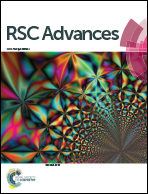Controlled growth of a nanoplatelet-structured copper sulfide thin film as a highly efficient counter electrode for quantum dot-sensitized solar cells†
Abstract
An ideal counter electrode (CE), with high-level electrocatalytic activity, high performance stability, and applicable fabrication simplicity, is significant to convey the advantages of quantum-dot-sensitized solar cells (QDSSCs). We report CuS nanoplatelets that are cohered on a conductive FTO substrate using an inexpensive and facile one-step low-temperature chemical bath deposition technique with different concentrations of acetic acid and can be employed as CE without any post-treatments for QDSSCs. The acetic acid affects the morphology, density of nanostructure, thickness, and Cu vacancies with increased S composition of CuS. The TiO2/CdS/CdSe/ZnS QDSSC with the optimized CuS CE under one sun illumination (AM 1.5G, 100 mW cm−2) exhibits an energy conversion efficiency (η) of 5.15%, which is higher than that of a platinum (Pt) CE (1.25%). This enhancement is mainly attributed to the optimized CuS nanostructure, which exhibits a lower charge transfer resistance (7.89 Ω) at the interface of the CE/electrolyte and superior electrochemical catalytic ability. A preliminary stability test reveals that the CuS CE exhibits good stability with no degradation for 20 h. Therefore, the easily prepared CuS is very promising as a stable and efficient CE for QDSSCs.


 Please wait while we load your content...
Please wait while we load your content...